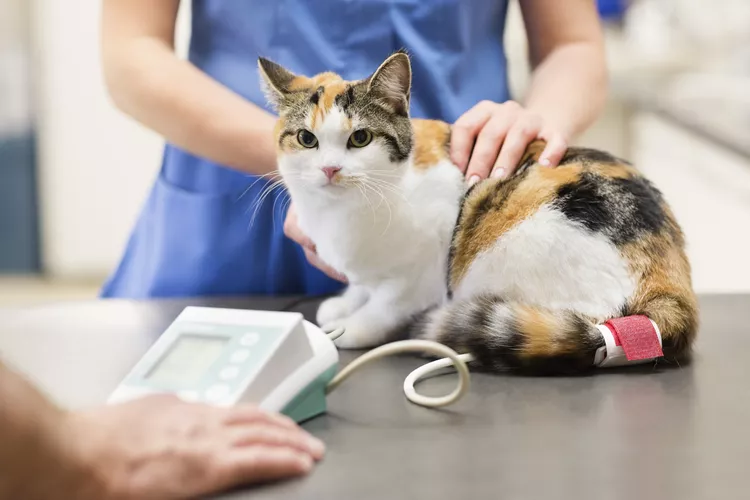Have you ever watched a cat calmly purring and wondered if their soothing presence could be more than just comforting to their owners?
While dogs and miniature horses are commonly recognized as service animals under the Americans with Disabilities Act (ADA), cats have carved out their own niche in the area of therapy animals.
Unlike service animals, therapy cats primarily offer emotional support and comfort to various groups of people, not just their owners.
Imagine a therapy cat visiting a nursing home or a school, where its mere presence could lift the spirits of individuals facing challenges.
These cats aren’t just pets; they’re partners in healing, providing a unique kind of support that differs significantly from that of service animals.
This article will explore how cats can serve as therapy animals and the impact they can have on human lives, shedding light on their roles and the joy they bring into communal spaces.
Read more: The Real Reason Your Cat Stretches When Seeing You!
What’s The Difference Between A Therapy Animal And Emotional Support Animal?
Therapy animals and emotional support animals (ESAs) play distinct roles, albeit both provide significant benefits.
As I’ve come to learn, therapy animals, like the therapy cats mentioned earlier, undergo specific training to offer comfort and support in various public settings such as schools, hospitals, and nursing homes.
These animals are trained to interact with multiple people other than their handlers.
For example, a therapy cat might visit a children’s hospital to help reduce patients’ anxiety levels.
On the other hand, emotional support animals offer companionship and emotional stability to their owners and are not required to undergo formal training.
Their primary role is to provide therapeutic benefits through companionship at home.
ESAs help mitigate psychological symptoms of their handlers’ disabilities, such as depression or anxiety.
Unlike therapy animals, ESAs usually support one individual and aren’t trained for public interaction.
Besides, it’s crucial to recognize that the legitimacy of an ESA comes from an official letter prescribed by a Licensed Mental Health Professional (LMHP), not from a registration or certification that many misleading websites might suggest.
I’ve learned that requesting an ESA accommodation in non-pet-friendly housing or on a flight usually requires presenting this ESA letter.
Hence, while both types of animals serve to aid emotional and psychological health, their training, the breadth of their interaction with humans, and legal recognition differ considerably.
Read more: The Power Dynamics Of Cat-Human Interaction: Who’s Really In Control?
Can Cats Be Therapy Animals?
Yes, cats can certainly serve as therapy animals.
Unlike service animals, which include only dogs and miniature horses, cats find their niche in the area of therapy animals.
Therapy animals, such as cats, engage in activities that primarily offer comfort and support to individuals other than their handlers.
A therapy cat works as part of a team with their handler to visit facilities like hospitals, nursing homes, and schools.
The aim here is to alleviate stress, provide affection, and foster emotional or social interaction among the people they meet.
For instance, a therapy cat visiting a senior living facility might sit on a resident’s lap, offering quiet companionship that can significantly boost the resident’s mood and emotional well-being.
But, it’s imperative to ensure that a cat suitable for therapy work exhibits the right temperament.
A good therapy cat should be calm, friendly, and comfortable in a variety of environments.
Importantly, they mustn’t show any aggression towards people or other animals.
Cats with a naturally outgoing and placid personality often make the best candidates.
Besides, to prepare a cat for therapy roles, they typically undergo specific training and certification through a recognized organization.
Programs such as Pet Partners or Therapy Pets Unlimited often provide these services, which help ensure that the animals are safe and effective in their roles.
In terms of practical steps, if you’re considering training your cat to be a therapy animal, start by assessing their suitability based on their behavior and health.
Next, engage with a reputable organization that can provide certification and training.
Then, once certified, gradually introduce your cat to the environments where they’ll be working, ensuring they are comfortable and responsive.
Hence, while cats cannot be service animals, they excel in therapeutic settings, offering invaluable comfort and joy to those in need.
Remember, a therapy cat’s role is to aid others through their presence—a simple yet profound service.
Read more: Why Do Cats Bite Their Nails? What Is Actually Behind This Habit?
What Does A Therapy Cat Do?
Therapy cats are trained to handle a variety of social situations and maintain calm in environments that could otherwise seem stressful or alien.
For instance, during a visitation session in a nursing home, a therapy cat might sit quietly on a resident’s lap, permitting petting and providing gentle companionship.
This simple act significantly reduces feelings of loneliness and anxiety among the elderly.
Besides, in educational settings like schools, therapy cats help to boost morale and encourage positive social interactions among students.
A common scenario might involve a therapy cat participating in a group reading session, where children take turns reading aloud while the cat calmly listens.
This not only helps in reducing stress associated with public speaking but also improves literacy skills and builds confidence in young readers.
Also, therapy cats contribute to therapeutic activities by being part of structured therapy sessions.
Licensed therapists often include these cats in individual or group therapy to foster emotional expression among participants.
For example, sharing space with a cat can help individuals who struggle with emotional restraint to open up and express their feelings more freely.
Therapy cats also undergo specific training to not just handle, but to actively contribute to the therapeutic environment.
Organizations like Pet Partners provide certification that prepares a cat to be attuned to human emotions and react soothingly.
The presence of a certified therapy cat can decrease cortisol levels and increase serotonin in patients, thereby enhancing mood and emotional well-being.
Overall, the impact of therapy cats in these settings is profound and heartwarming.
Their calm demeanor and affectionate nature make them excellent companions for those in need of emotional support.
Read more: Are Domestic Cats Related to Big Cats?
How To Find A Therapy Cat
Finding a therapy cat involves understanding where to look and how to identify the right fit for specific therapeutic needs.
My journey into the area of therapy animals has taught me that there are structured paths one can follow to locate and integrate these wonderful companions into therapeutic settings or personal care routines.
Explore Accredited Organizations
The foremost step in finding a therapy cat is to connect with accredited organizations like Pet Partners.
These organizations maintain networks of certified therapy cats trained to engage in therapeutic interactions.
For example, Pet Partners oversees a rigorous evaluation process to ensure that all its therapy cats meet high standards of behavior and temperament that are crucial in sensitive environments like hospitals and schools.
Check Local Shelters
Many local animal shelters and rescue groups have programs or partnerships dedicated to identifying and training potential therapy cats.
By visiting these shelters, you can inquire about any cats that are currently in a training program or have the temperament suited for therapy work.
Shelters often have insights into the personality traits of their animals, which can be beneficial if you’re looking for a cat that can handle frequent human interactions in various environments.
Attend Training Programs
If you’re considering having your personal cat trained as a therapy cat, attending training programs offered by qualified organizations is essential.
These courses cover everything from basic obedience to more specialized training that prepares cats to remain calm and supportive in a variety of potentially challenging situations.
It’s important to expose your cat to a wide range of scenarios during training to ensure they react appropriately in real-world therapeutic settings.
Read more: How Long Do Outdoor Cats Live? The Sad Truth
Evaluate The Cat‘s Temperament
An essential consideration is the temperament of the cat.
The ideal therapy cat should display a calm and friendly disposition.
They must cope well with unfamiliar environments and a variety of people.
During the selection process, look for signs of a sociable and relaxed nature, like a willingness to approach people and a calm response to new and unusual sounds or movements.
By following these paths, you can find a therapy cat that not only meets the criteria set forth by professional organizations but also connects with you on a personal level, enhancing the therapeutic experience for everyone involved.
Therapy Cat Training
Training programs vary, but most adhere to guidelines that ensure the cat can handle diverse situations without stress.
For example, a typical training program might include exposure to different settings such as hospitals, schools, or nursing homes.
This helps the cat become accustomed to various noises, smells, and a large number of people.
Organizations like the International Association of Human-Animal Interaction Organizations (IAHAIO) often provide a curriculum that includes desensitization exercises to prepare cats for these environments.
Also, therapy cats must undergo health checks to ensure they are up to date on vaccinations and maintain optimal health.
This is crucial, as they interact with populations that may be vulnerable to allergens or zoonotic diseases.
Part of the training also involves teaching the owner or handler.
They learn about animal welfare, signs of stress in their cat, and how to intervene effectively if their cat becomes overwhelmed.
Training isn’t only about the cat‘s ability to cope but also empowering the handler to lead interactions that are safe and beneficial for everyone involved.
Successful completion of a therapy cat training program often culminates in an evaluation.
Here, the cat must demonstrate its ability to remain calm and responsive in unfamiliar settings.
Only after passing such assessments does a cat receive certification from reputable organizations.
This certification can sometimes involve a detailed behavioral test conducted by a professional in the animal therapy field.
Hence, if you’re considering training your cat to become a therapy animal, it’s crucial to connect with accredited organizations.
They’ll guide you through the training requirements and help set you and your cat up for success in this rewarding try.
Read more: The Dark Side Of Meowing: How Cats Manipulate Their Owners
Benefits Of Having A Therapy Cat
Owning a therapy cat brings exceptional rewards, particularly in terms of emotional and psychological benefits.
These feline friends contribute significantly to therapeutic processes, providing more than just companionship. Their mere presence can alter the emotional atmosphere of a room.
Therapy cats are known to reduce stress and anxiety.
Interacting with a cat can lower blood pressure and decrease feelings of loneliness or isolation.
For example, in hospitals, patients often experience relief and a calmer state of mind following a visit from a therapy cat.
The soothing purr and soft fur of these animals provide a comforting sensory experience that can distract from pain and discomfort.
Also, therapy cats contribute to improved mood and increased sociability among patients in settings like nursing homes or rehabilitation centers.
Their gentle and playful nature makes them perfect companions for therapeutic visits, helping to alleviate symptoms of depression and boosting overall morale.
In schools, children with developmental challenges such as autism spectrum disorders often find therapy cats helpful in social interactions, which can otherwise be challenging for them.
Read more: The Real Reason Your Cat Stretches When Seeing You!
How To Get Your Cat Certified As A Therapy Cat
Embracing the role of therapy cats in our lives underscores a profound appreciation for the unique support these animals provide.
If you’re considering this path for your cat, it’s essential to ensure they’re properly trained and certified.
Start by reaching out to accredited organizations that can guide you through the process.
They’ll help you understand the training requirements and connect you with resources to prepare your cat for its new role.
Remember, the journey to certification is not just about training—it’s about enhancing the natural bond between you and your cat ensuring you both are ready for the rewarding experiences ahead.
Together you can bring joy and comfort to those in need creating a ripple effect of positivity in your community.







